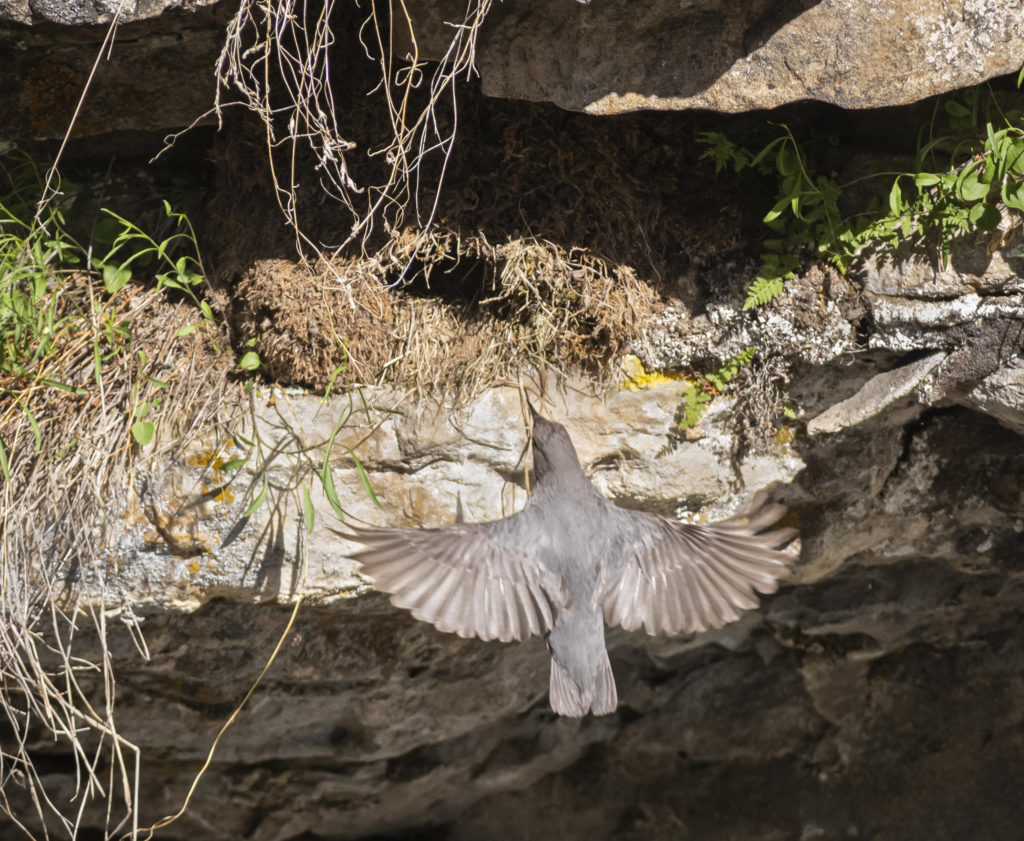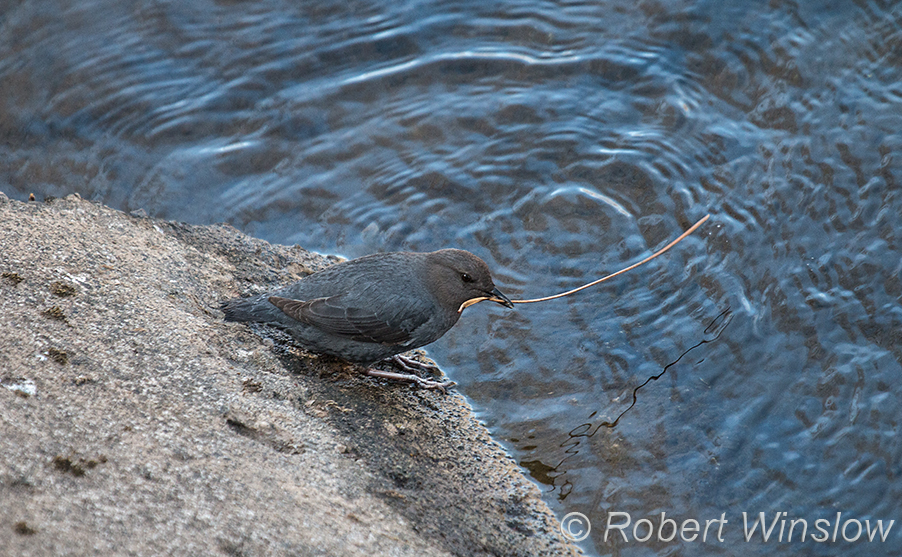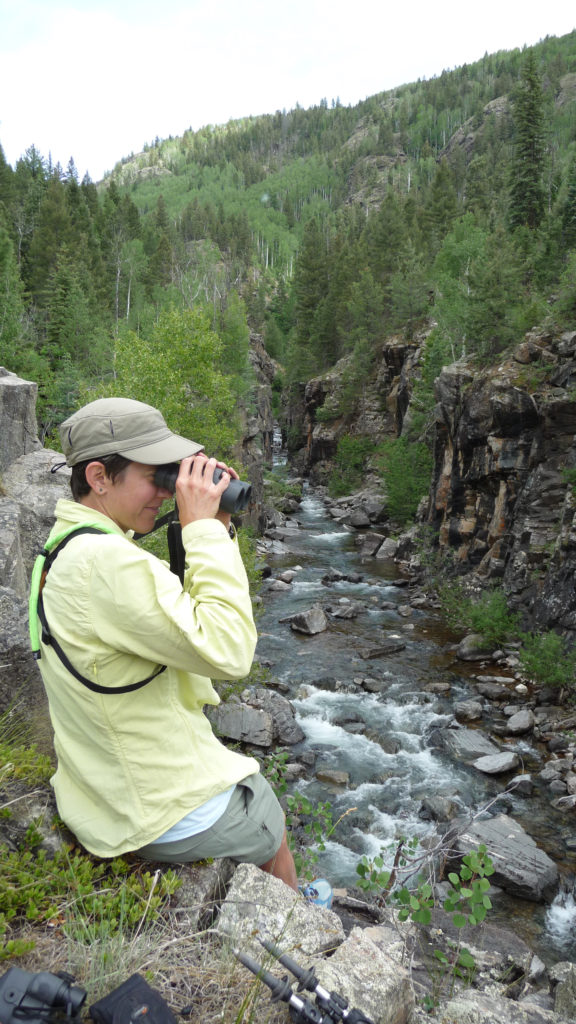Troubled Waters: a Homegrown Effort to Track American Dipper Success
August 27, 2021By Stephen Monroe and Shelley Silbert
The Gold King Mine spill of 2015 introduced three million gallons of toxic mine drainage into a tributary of the Animas River near Silverton, Colorado. It was an environmental disaster for humans and animals. The very next year, concerned birdwatchers in Durango launched The American Dipper Project, a community science investigation into the potential impacts of the spill on breeding American Dippers. American Dippers are a western species of aquatic songbird that require rushing, unpolluted waters in which to forage, and the mine spill had the potential to threaten their persistence in the watershed.
The project’s objective is to study the breeding success of American Dippers on the Animas River and other streams in southwestern Colorado. Each year from 2016 through 2021, citizen science volunteers have surveyed American Dippers to learn about nesting behavior, nesting success, and nest site fidelity. During field surveys, volunteers look for signs of courtship and nesting activity including copulation, nest building, incubation, feeding of nestlings, and presence of fledglings. In 2021, the project was expanded to the upper San Juan River near Pagosa Springs. Nesting data are entered into the NestWatch database following each field season.

Life On The River
An adult American Dipper arrives at its nest on the Piedra River.
Rising From the Ashes
Unfortunately, the mine spill was not the end of the hardship. In June 2018, a catastrophic wildfire burned portions of the Animas River watershed, and the subsequent flooding introduced large volumes of ash and sediment to the river, adding yet another negative impact to the dippers’ habitat and food sources. For American Dippers to thrive, they need availability of suitable nesting habitat and food. Their diet consists of aquatic macroinvertebrates, like larvae of caddisflies, mayflies, and stoneflies, as well as small fish, fish eggs, and worms. Surveys of macroinvertebrates in the Animas River before and after the 2018 wildfire showed that after the fire there was a decreased diversity of insects which dippers require for food (Mountain Studies Institute 2021). Colorado Parks and Wildlife reported that approximately 80% of the fish in the Animas River were killed due to high levels of ash and debris in the river after the fire (White 2020). With time, the macroinvertebrate population has begun to recover, but by 2021 it was not yet back to pre-fire levels.
Water Under the Bridge

Time To Build
An American Dipper collects nesting material by the Animas River in Durango, Colorado.
In their natural habitat, dippers build nests of moss, grass, algae or twigs. Preferred nest sites are close to water, safe from predators, and often on cliffs from 1–10 meters above a flowing river. Dippers also build nests on bridges and other human-made structures. In the spring of 2020, we discovered a nesting pair of dippers under a highway bridge over Hermosa Creek north of Durango. Hermosa Creek is a tributary of the Animas River and drains the watershed burned by the 2018 wildfire, and the presence of nesting dippers was an encouraging sign of watershed recovery. We learned the Colorado Department of Transportation (CDOT) was planning a maintenance project on the bridge during the nesting period. We informed CDOT about the nesting dippers and consequently CDOT postponed the project. The American Dipper is protected by the federal Migratory Bird Treaty Act, which prohibits disturbance of active nests. In early June that year, we observed two fledglings dipping and dancing on top of the nest, two nestlings watching from inside, and both parents singing on a nearby beach. A day later, all four fledglings had left the nest and headed upstream. The bridge construction project was delayed, but CDOT completed the project later in June. Through our vigilance, we were able to save this one dipper nest!
Threats to the American Dipper

Another Day In Paradise
A volunteer monitors a dipper nest from a scenic vantage point. Dipper nests can be difficult to access, and more distant monitoring is sometimes needed.
The following threats put American Dippers at risk in southwest Colorado:
Mining. Mining for gold and silver mobilizes heavy metals, and leaves behind a legacy of human and wildlife health hazards. Of particular risk to dippers are lead, copper, zinc, selenium, and cadmium. High concentrations of these metals in the river can limit reproductive success and even cause death. Sadly, the Animas River has been negatively impacted by heavy metal contamination due to historic mining activities for more than a century.
Climate change. In recent years, the size and severity of wildfires in the western United States has increased mostly due to rising temperatures resulting from climate change. The devastating effects of wildfire and the resultant runoff creates heavy sediment loads that can negatively impact the dippers’ food supply by limiting macroinvertebrate populations. Additionally, when streamside vegetation burns, dippers lose important habitat, resulting in both the loss of shade that protects them from the sun and the loss of shelter that protects them from predators, and such loss of vegetation can also lead to increased stream temperatures. Variability in precipitation, temperature, and the timing of snowmelt can affect when macroinvertebrates hatch, altering food supply during critical nesting periods (Nilsson et al. 2011). Extended periods of drought can also result in extremely low flows or sometimes complete drying of perennial streams. Temperature increases in late spring and early summer due to climate change can coincide with the nesting season. Dippers in southwest Colorado are altitudinal migrants and typically spend winters at lower elevations. They do not tolerate high air temperatures, and when temperatures rise above about 91 °F, dippers can’t prevent their body temperature from rising to dangerous levels, which can lead to nest failure and death (Murrish 1970).
Microplastics. There’s been increasing recognition of the presence of microplastics in the environment. In 2020, a study in national parks and wilderness areas in the western U.S. found that microfibers from clothing and carpeting made up most of the synthetic materials found in air samples from atmospheric deposition (Brahney et al. 2020). A 2020 study on the European Dipper in South Wales discovered that they consume high levels of microplastics that have moved up through the food chain (D’Souza et al. 2020). Studies of microplastics in American Dippers have not yet been done, but there is ample evidence of microplastics in Colorado’s rivers. This aspect of their ecology needs urgent study.
Want to help?
Surveyors are needed to monitor both the disturbed reaches of the Animas River, and tributary streams that have not been affected by mining or wildfire. For additional information about The American Dipper Project and to be included in the volunteer participant list, contact the Weminuche Audubon Society. We are grateful for the support provided to The American Dipper Project by Audubon’s Western Water Network.
References:
- Brahney, J., M. Hallerud, E. Heim, M. Hahnenberger, and S. Sukumaran. 2020. Plastic rain in protected areas of the United States. Science 368(6496):1257–1260.
- D’Souza, J. M., F. M. Windsor, D. Santillo, and S. J. Ormerod. 2020. Food web transfer of plastics to an apex riverine predator. Global Change Biology 2020(00):1–12.
- Mountain Studies Institute. 2021. The 416 fire: post-fire impacts and recovery of watersheds and forests. Available at: https://storymaps.arcgis.com/stories/ba65b6213d774e5ab4d57635fdb54061
- Murrish, D. E. 1970. Responses to temperature in the dipper, Cinclus mexicanus. Comparative Biochemistry and Physiology 34(4):859–869.
- Nilsson, A. L. K., E. Knudsen, K. Jerstad, O. W. Røstad, B. Walseng, T. Slagsvold and N. C. Stenseth. 2011. Climate effects on population fluctuations of the White-throated Dipper Cinclus cinclus. Journal of Animal Ecology 80(1):235–243.
- White, J. 2020. Animas River, Durango: Fish survey and management information. Colorado Parks and Wildlife, Durango, CO. 4pp. Available at: https://cpw.state.co.us/thingstodo/Fishery Survey Summaries/AnimasRiverDurango.pdf

6 comments on “Troubled Waters: a Homegrown Effort to Track American Dipper Success”
Love the Dippers. Glad someone is championing them. They are found here in Utah as well.
Also, I think the statement, “Climate change. In recent years, the size and severity of wildfires in the western United States has increased mostly due to rising temperatures resulting from climate change,” deserves a citation, though. We do not want anyone to think we are making this up from unscientific sources.
Hi Brent. Good question. The excellent resource here from Mountain Studies Institute describes the relationship between climate change, increased drought severity, and greater fire risk. The full citation is in the reference list.
Thanks to young bird watcher concerning about nesting of Dipper. In India we are far away from this activity.
Thanks for the good work in trying to create a good shelter for the birds. Keeping a good habit for the future generation not only to humanity but also to the C. mexicanus species. Reading from Kenya, Nairobi
wow
wow i did not know that